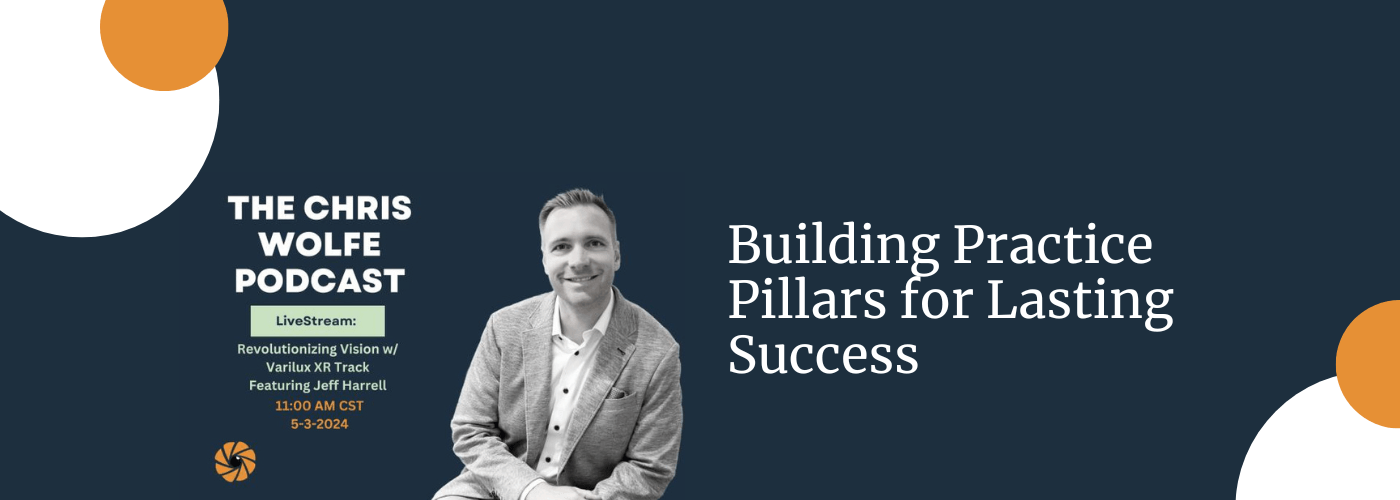

In any optometric practice, having a clear understanding of the foundational elements—or pillars—that support your business can significantly impact patient outcomes and practice growth. These pillars aren’t just the financial drivers of your practice but are critical in maintaining the overall health and success of your business. In a recent episode of the Chris Wolfe Podcast on EyeCode Media, we dive deep into the concept of building pillars within optometric practices and highlights how these pillars serve as the foundation for managing both routine and chronic conditions in patients.
What Are Pillars?
In an optometric practice, pillars refer to areas of the business that provide stability and structure. These could include glasses and contact lens sales, dry eye management, glaucoma treatment, macular degeneration care, and surgical co-management, among others. The key idea here is that pillars are not just financial elements but also include clinical services that help patients manage chronic diseases. For many practices, glasses and contact lenses tend to dominate as the primary pillars. However, expanding this perspective to include disease state management can open up new opportunities for practice growth and patient care.
Chris illustrates this point by talking about how practices often undervalue the management of chronic diseases. By identifying these diseases as pillars and creating structured systems for managing them—just like you would for glasses and contact lenses—you can significantly enhance both the patient experience and practice revenue. It’s not just about generating income but also about ensuring that your practice provides comprehensive care that truly benefits the patients.
The Importance of Ownership
One of the first things Chris emphasizes is the importance of ownership when building pillars in your practice. Ownership means creating a framework that works specifically for your practice, as opposed to copying someone else’s system. While examples and templates from other practices can provide guidance, they won’t be as effective if you don’t fully understand and own the processes you’re implementing.
A key part of this ownership involves defining why a particular pillar is important for your practice. Take annual supply contact lens sales as an example. Chris suggests starting by understanding why this is beneficial for the patient. In this case, having an annual supply of contact lenses ensures that patients are more likely to replace their lenses regularly, reducing the risk of eye irritation and other complications. For the practice, it can also increase revenue, minimize patient interaction for reordering, and keep patients from purchasing lenses elsewhere.
By going through this process with your team, you ensure that everyone understands the value of the pillar for both the patient and the practice. When the whole team is on board, it’s easier to implement and sustain that pillar over time. This sense of ownership is critical—without it, any framework you try to implement will likely fall flat.
Building Systems Around Pillars
Once you’ve defined your pillars, the next step is building systems to support them. Whether the pillar is contact lens sales or chronic disease management, having a structured system in place ensures that your practice consistently delivers quality care and service. Chris discusses how important it is to create systems that actively identify and manage patients with chronic diseases, like glaucoma or dry eye. These systems allow practices to be purposeful about their approach, ensuring that patients receive the care they need without it falling through the cracks.
For example, when managing dry eye, the practice could implement a step-by-step process for identifying and addressing symptoms. This might include asking specific, yes-or-no questions that highlight whether the patient is experiencing dryness or irritation. Once the practice has identified the problem, they can act on it immediately, creating a structured approach to managing the condition.
Avoiding Common Pitfalls: Pillars vs. Widgets
A common mistake many optometrists make when building pillars is focusing too much on specific treatments or equipment—what Chris refers to as “widgets”—rather than the broader disease state. For example, a practice may invest in an expensive piece of equipment to treat dry eye, only to find that it doesn’t yield a return on investment because not every patient needs that specific treatment. This can lead to frustration and financial loss.
Chris advises focusing on the disease state itself rather than on any one particular treatment. In the case of dry eye, this means understanding the different components of the disease—such as evaporative issues, inflammation, and tear volume—and having a range of treatments available to address each component. By building the pillar around the disease state, the practice is less likely to crumble if one treatment doesn’t work. This approach ensures that the practice can still manage the disease effectively, even if a specific treatment fails.
Asking the Right Questions
One of the most critical aspects of building a pillar is identifying the right questions to ask your patients. These questions should be so important that you can’t ignore a positive response. For example, if a patient answers yes to experiencing dry, scratchy eyes, this should immediately trigger further evaluation and treatment. Having these key questions in place ensures that you don’t overlook important symptoms and that your practice is consistently delivering high-quality care.
Your set of key questions may differ from other practices, and that’s okay. What’s important is that these questions are existential to your practice—they are critical to your ability to deliver the best possible care. If you can’t turn away from a patient’s positive response to one of these questions, then you’ve successfully built a pillar that will support your practice in the long term.
Addressing Challenges
Building pillars is not without its challenges. One of the common pitfalls Chris highlights is the tendency to view a pillar as a “widget” that can easily be replaced or abandoned if it doesn’t immediately yield results. Instead, Chris encourages a more strategic approach: build pillars around disease states rather than specific treatments, and always be prepared to adjust your approach if a particular treatment isn’t working.
This flexibility is key to maintaining the strength of your pillars. If one treatment fails, having other options available ensures that the pillar doesn’t collapse entirely. It’s this holistic approach—focusing on the broader disease state rather than any one treatment—that will ultimately lead to long-term success.
Conclusion
Building pillars within your optometric practice is about more than just identifying revenue streams—it’s about creating a structure that supports both patient care and practice growth. By taking ownership of the process, building systems around chronic disease management, and avoiding the pitfalls of focusing too much on specific treatments, you can create a strong foundation that will sustain your practice for years to come. Pillars should be built around the needs of your patients, with the understanding that helping them will, in turn, help your practice thrive.
If you're interested in being a part of an online community with on-demand courses to help optometrists increase medical management and medical insurance utilization to grow their practice, check it out our Comprehesnive Optometry Simplifiend Bundle!

